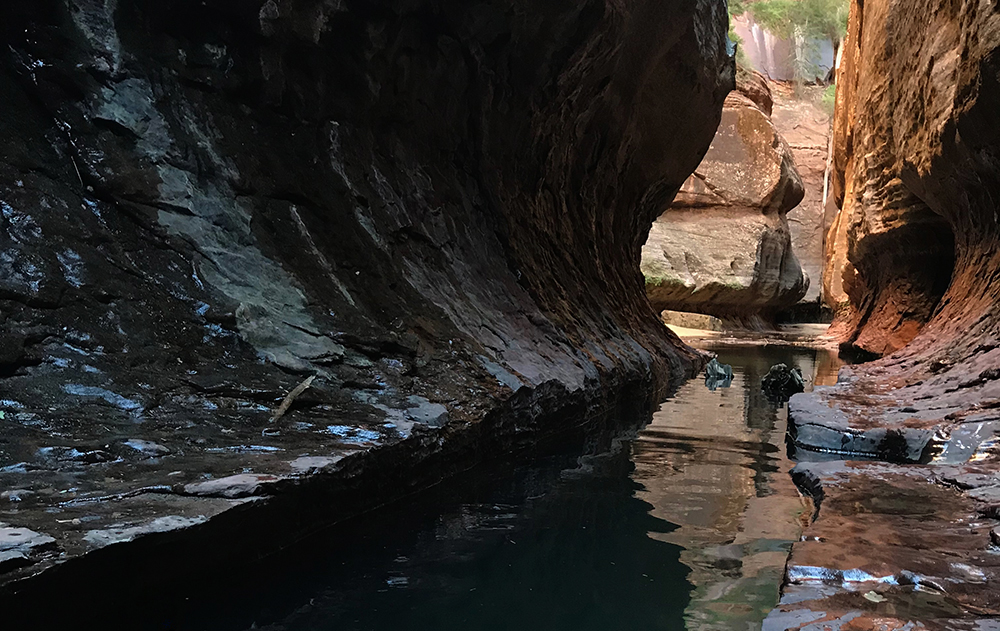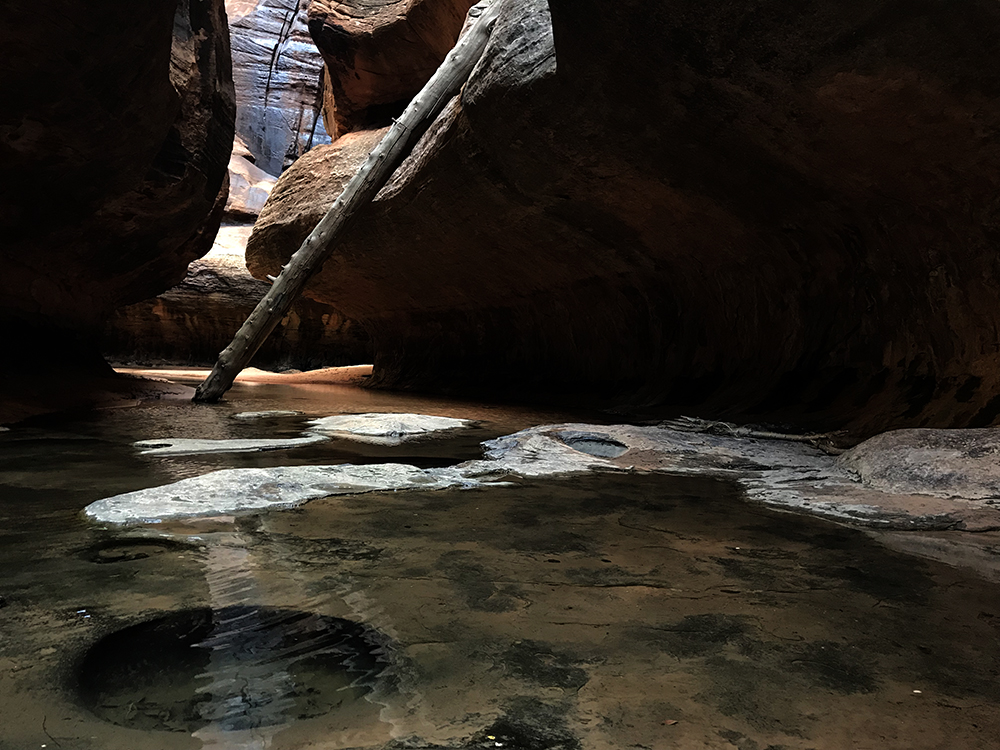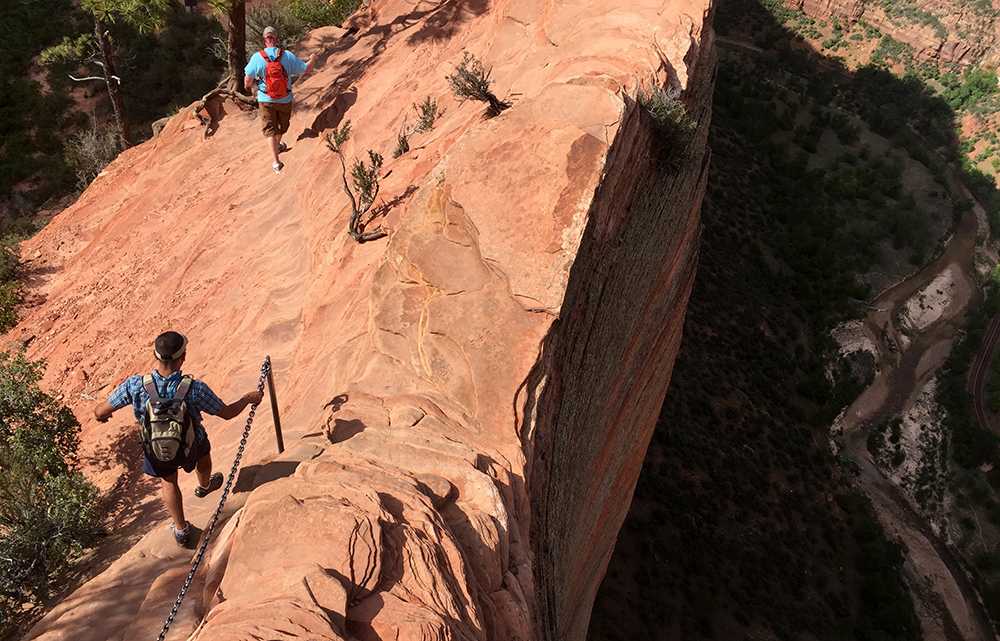Zion is a land of endless canyons which lie divided by vertical walls of sandstone that sometimes appear as thin as a knife edge. This park has been molded by the force of water combined with time… The geology of Zion National Park tells a story that took tens of millions of years to write… And the author is still writing.

Guide to Zion
A Land of Sandstone Sliffs
Zion Canyon is the most prominent of the park’s canyons. It lies flanked by massive sandstone cliffs that tower more than 2,000 feet above the seemingly innocent waters of the Virgin River. These are among the tallest sandstone walls in the world. They proudly showcase at least six separate layers of rock strata, which were deposited over a period of some 200 million years.
The stratified rock witnessed at Zion is, at its core, comprised of individual grains of sand. These tiny grains were washed westward long-ago by mighty rivers running from the once-soaring heights of the Appalachian Mountains, far to the east.

Rock Made of Sand
Over the course of the past couple hundred million years, this area has witnessed great change. Low lying inland seas occasionally covered her sands. At other times, great rivers have carried her sands away. Blankets of wind-swept dunes have climbed toward the sky, while decaying organic matter compressed into stone amid layers of mud and muck.
These layers slowly consolidated into petrified conglomerates of limestone, shale and sand, cemented together by lime, silica and iron. Such elements slowly permeated the grains of sand, which were ultimately compressed into stone by the massive weight of the materials above over millions of years. The varying layers of strata we find today, indicate different periods of time during which these rocks were formed.

Beginning an estimated 13 million years ago, these massive dunes of petrified sand began to rise from the Earth’s crust. The resulting uplifted block of sandstone formed a massive plateau that is today known as the Colorado Plateau. This unique feature covers parts of Arizona, Colorado, New Mexico and Utah, including Zion at its western boundary.
The Grand Staircase
Together with Bryce Canyon NP to the east, and the Grand Canyon NP to the south, Zion exists as the middle layer of what is called the “Grand Staircase”. The Staircase is a geologic feature in which some 16,000 feet of sedimentary rocks are exposed among these three national parks. The bottom layer of rock at Bryce, is the same as the top layer at Zion, while the bottom layer at Zion, is the top layer at the Grand Canyon. In these layers, are incorporated the records of a thousand million years…
This sandstone uplift was quickly eroded by the forces of nature, primarily the flow of water. The lands of southern Utah are riddled with deep canyons that are relatively young, geologically speaking. Most of this erosion takes place in very short bursts of time, with violent flash floods bearing responsibility for the rapid removal of large amounts of debris and particles of rock.
The Virgin River
The average visitor may look at the Virgin River and doubt its influence on the scenery that unfolds before them. This tranquil waterway often appears to be nothing more than a peaceful brook. It seems inconceivable that this river could have gouged this canyon out of the surrounding landscape.
The Virgin River transports more than a million tons of sediment out of the park each year. The majority of this sediment is washed away during flash floods. The desert landscape witnessed here is not formed by the absence of water.
Quite the contrary, it is the very result of water’s brief, yet violent presence. Massive storms roll over the southwest in the late summer, dropping intense levels of moisture on the Colorado Plateau. The elevation of the plateau means that the water will run downhill, and fast!
If the elevation of the Colorado Plateau was not thousands of feet higher than surrounding landscapes, these canyons would not have formed quite as they did. When one studies the effects of water flow, it becomes clear that the steeper the terrain, the faster the flow, which means more power to cut into the soil over which it flows.
When that intense water flow runs over sandstone, which is relatively soft rock, it can have a devastating effect, and can carry away millions of tons of debris in a short period of time. That is exactly what is happening in the Virgin River.
Yep, that lil river carved that massive canyon…
The Erosion Continues
As time continues, the construction of Zion continues. The Virgin River will continue to cut deeper into the sandstone core of the park and its surrounding areas. As you visit Zion, try to transport yourself into the future by several hundred thousand years. What do you see now? How is Zion different in that world?
Now try several million years… and several more…
Enjoy…
Guide to Zion
Relevant Links
National Park Guides

All content found on Park Junkie is meant solely for entertainment purposes and is the copyrighted property of Park Junkie Productions. Unauthorized reproduction is prohibited without the express written consent of Park Junkie Productions.
YOU CAN DIE. Activities pursued within National Park boundaries hold inherent dangers. You are solely responsible for your safety in the outdoors. Park Junkie accepts no responsibility for actions that result in inconveniences, injury or death.
This site is not affiliated with the National Park Service, or any particular park.
